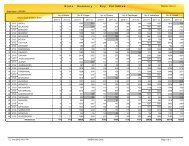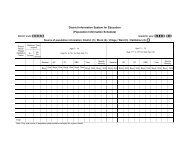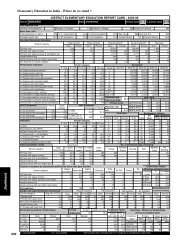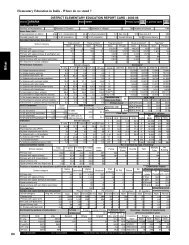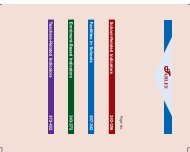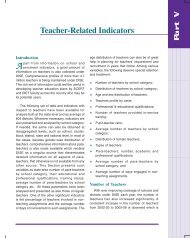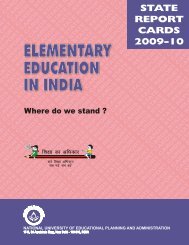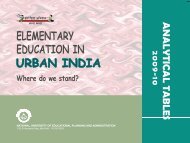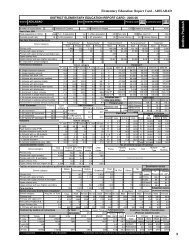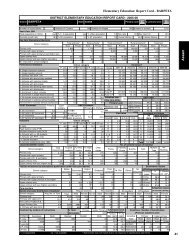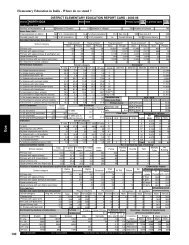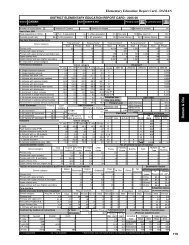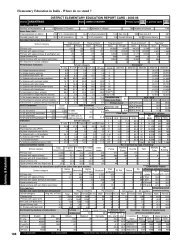Teacher Related Indicators & EDI - DISE
Teacher Related Indicators & EDI - DISE
Teacher Related Indicators & EDI - DISE
You also want an ePaper? Increase the reach of your titles
YUMPU automatically turns print PDFs into web optimized ePapers that Google loves.
<strong>Teacher</strong>-<strong>Related</strong> <strong>Indicators</strong><br />
Part IV<br />
percent). In urban areas, the percentage of such teachers<br />
is 0.68, 0.62 and 0.64 respectively in case of male,<br />
female and all teachers together.<br />
The distribution of Primary school teachers in<br />
position by qualifications (Table<br />
D-15) reveals that majority of<br />
the teachers are Higher<br />
Secondary and below (total<br />
54.91 percent against 55.77<br />
percent in 2006-07, male 55.65<br />
percent, and female 53.89<br />
percent). About 3.54 percent<br />
male and 3.62 percent female<br />
teachers are below Secondary<br />
level and another 31.71 percent<br />
male and 30.21 percent female<br />
teachers have completed<br />
Secondary level of education.<br />
Not much difference is noticed<br />
in percentages of teachers below Secondary level in rural<br />
areas and urban areas but the same is not true in the<br />
case of teachers having Graduate and Post-Graduate<br />
degrees. Further, it is observed that percentage of female<br />
Table D14<br />
Academic Qualification of All Category Regular <strong>Teacher</strong>s: 2007-08<br />
Qualification All Areas Rural Areas Urban Areas<br />
Male Female Total Male Female Total Male Female Total<br />
Below Secondary 2.56 2.61 2.58 2.57 2.74 2.63 2.52 2.39 2.44<br />
Secondary 16.11 17.75 16.81 16.72 18.84 17.47 12.39 15.79 14.61<br />
Higher Secondary 24.15 24.15 24.15 25.40 27.89 26.29 16.55 17.42 17.12<br />
Up to Higher 42.82 44.51 43.54 44.69 49.47 46.39 31.46 35.60 34.17<br />
Secondary Level,<br />
2007-08<br />
Up to Higher 44.27 45.32 44.71 46.28 50.39 47.71 32.10 36.55 34.99<br />
Secondary Level,<br />
2006-07<br />
Graduate 37.72 35.55 36.80 36.79 32.54 35.29 43.41 40.93 41.80<br />
Post Graduate 18.50 18.65 18.56 17.66 16.82 17.36 23.59 21.96 22.52<br />
Graduate & Post 56.22 54.20 55.36 54.45 49.36 52.65 67.00 62.89 64.32<br />
Graduates, 2007-08<br />
Graduate & Post 54.49 53.25 53.97 52.61 48.38 51.14 65.91 61.68 63.16<br />
Graduates, 2006-07<br />
M.Phil/ Ph.D 0.41 0.52 0.46 0.37 0.47 0.40 0.68 0.62 0.64<br />
Others 0.44 0.64 0.52 0.38 0.53 0.43 0.76 0.83 0.80<br />
No Response 0.11 0.13 0.12 0.11 0.17 0.13 0.10 0.06 0.07<br />
Note: Totals may not add to hundred because of rounding of figures.<br />
“It is observed that<br />
percentage of female teachers<br />
having Graduate and Post-<br />
Graduate degrees is a bit<br />
higher than their male<br />
counterparts, which is true<br />
for both rural and urban<br />
areas. Only 30.27 percent of<br />
the total Primary school male<br />
teachers are Graduates<br />
against 30.62 percent such<br />
female teachers”<br />
teachers having Graduate and Post-Graduate degrees<br />
is a bit higher than their male<br />
counterparts, which is true for<br />
both rural and urban areas. Only<br />
30.27 percent of the total<br />
Primary school male teachers are<br />
Graduates against 30.62 percent<br />
such female teachers. Another<br />
13.66 percent male and 14.57<br />
percent female teachers are<br />
Post-Graduates. A few of them<br />
have even M.Phil and Ph.D<br />
degrees (0.31 percent). About<br />
54 percent Primary school<br />
teachers in urban areas have<br />
Graduate and Post-Graduate<br />
degrees against about 43 percent in rural areas. It has<br />
171




